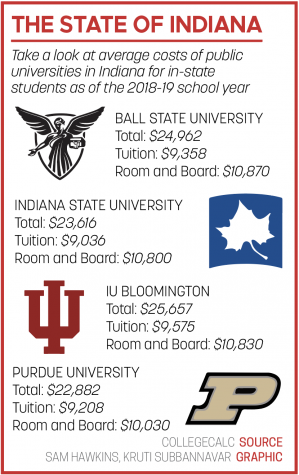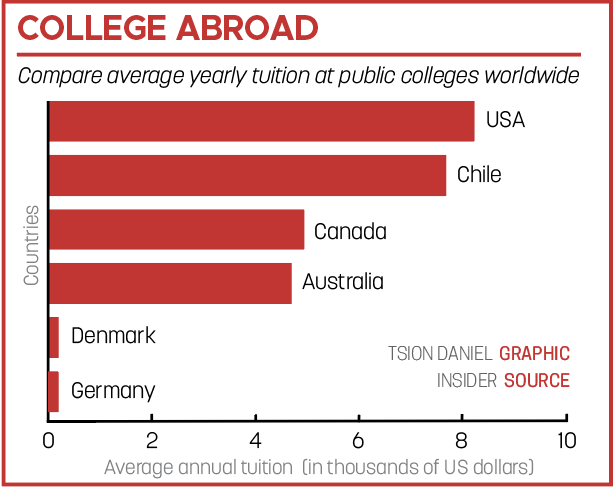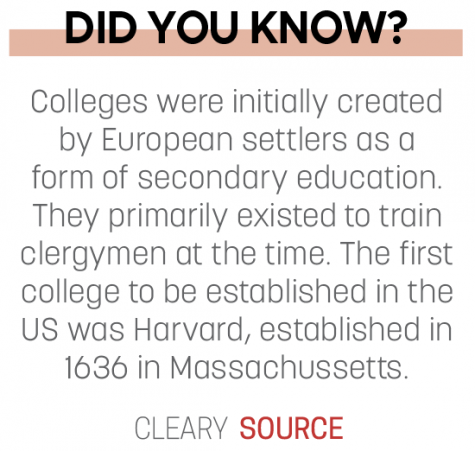For senior Lalith Roopesh, college tuitions are an important part of consideration when thinking about which colleges to apply to.
“Tuition definitely was a priority for me as I plan to pursue a graduate education, meaning I have to pay past a normal bachelor’s degree. I don’t want to take too many loans, so the cost of the college is very important, making in-state (college) a very powerful option,” he said. “While there are scholarships, usually options like IU and Purdue will end up being cheaper.”
 Roopesh is not alone—a February 2020 Pew Research Center poll found that 63% of American adults supported making public colleges tuition-free. Moreover, newly elected President Joe Biden has previously expressed support for making public colleges costless.
Roopesh is not alone—a February 2020 Pew Research Center poll found that 63% of American adults supported making public colleges tuition-free. Moreover, newly elected President Joe Biden has previously expressed support for making public colleges costless.
Brian Newman, director of policy and communications for the Campaign for Free College Tuition, said he believes the current discussion surrounding free public college is especially warranted because it is a continuation of the basic right to education.
“We view the access to public universities as similar to access to elementary and secondary education. We think that the current model, which is basically K-12 in public schools, should be expanded to K-16, or at the very least K-14, which would include a two-year degree at a community college,” Newman said. “Our organization is focused on making public colleges and universities tuition-free. We’re very much supportive of President Biden’s plan to do so, but we’ve also been working with state governments, state governors and state legislatures to make that happen. Currently about half the states in the country have some program to make public colleges tuition-free.”

In Indiana, some plans have been implemented in community colleges to increase accessibility and make classes free; notably, Ivy Tech Community College offered free classes to over 10,000 Indiana residents in light of the COVID-19 pandemic back in July. On a national scale, Newman said there are multiple possible steps that the Biden Administration may take based on their past views.
“As a candidate, Joe Biden released several initiatives related to college affordability and college access, one being to forgive up to $10,000 in student debt. The second is making public colleges and universities tuition-free. A subset of that plan is to make community colleges free for all, and there is a proposal that President Biden basically adopted from the (Bernie) Sanders (presidential) campaign to make four-year colleges tuition-free for families making up to $125,000. There’s a third proposal that the Biden Campaign has supported, which is doubling the Pell Grant, which provides assistance to lower-middle class students for postsecondary education,” he said.
Junior Shrithan Sandadi said he agrees the recent steps taken are beneficial, and that current college tuition processes need more reform.
“I believe that college tuition is overpriced and that colleges often prioritize getting funding over providing for the greatest possible study body,” Sandadi said via email. “Tuition will be one of my priorities (when applying for college) because one has to weigh whether or not it is worth it to go to certain colleges if at the expense of increased costs. It is also important to account for whether student debt will be a problem after college.”
Roopesh said he believed that the concept of tuition as a whole has garbled the original intention that colleges have as institutions—to provide education.
“I think that colleges are more invested in money than they should be. With education being a right, the model should be that all money is reinvested in the students in the form of resources or scholarships,” he said. “Currently, colleges seem to be asking for too much money that we don’t see returned in the quality of education. They should definitely focus on students more.”
Although there may be widespread support to make public colleges and universities tuition-free, Newman said the proposal itself could take a few years to actually implement.
“I would emphasize that there are a lot of proposals being floated currently in Washington, D.C., and the Biden Administration is still setting its legislative priorities—obviously, they have the COVID Relief package as their number one priority, but until they do that, we’re not sure of the timing and sequencing of when Congress will consider a free college bill, but we’re hopeful that will be this year or next (year), and we’re continuing to build support for that legislation when it takes place,” he said.
Newman also said there may be some additional obstacles involved from a state government perspective.

“Current proposal envisions some state matching funds, which potentially means that each state legislature or each state governor has to decide when or if they want to implement the proposal. I think there’ll be a number of states that do that right away, but there could be some states that take a few years to decide if that’s something they want to do.”
Roopesh said he hopes Congressional leaders include some of the recent plans towards making public college tuition-free as part of their priorities this year.
“Like much helpful policy, the longer they delay it the more people suffer. College students (or really anyone suffering from student debt) need to band together to make sure they vote leaders who support their interests, and government leaders should realize that this is what the American population needs,” he said.
Sandadi said he agreed.
“There are many barriers currently in place preventing students from accessing college education. The time is now to act and to pass legislation to remove these barriers and allow students greater access to education.”


































![AI in films like "The Brutalist" is convenient, but shouldn’t take priority [opinion]](https://hilite.org/wp-content/uploads/2025/02/catherine-cover-1200x471.jpg)










































![Review: “The Immortal Soul Salvage Yard:” A criminally underrated poetry collection [MUSE]](https://hilite.org/wp-content/uploads/2025/03/71cju6TvqmL._AC_UF10001000_QL80_.jpg)
![Review: "Dog Man" is Unapologetically Chaotic [MUSE]](https://hilite.org/wp-content/uploads/2025/03/dogman-1200x700.jpg)
![Review: "Ne Zha 2": The WeChat family reunion I didn’t know I needed [MUSE]](https://hilite.org/wp-content/uploads/2025/03/unnamed-4.png)
![Review in Print: Maripaz Villar brings a delightfully unique style to the world of WEBTOON [MUSE]](https://hilite.org/wp-content/uploads/2023/12/maripazcover-1200x960.jpg)
![Review: “The Sword of Kaigen” is a masterpiece [MUSE]](https://hilite.org/wp-content/uploads/2023/11/Screenshot-2023-11-26-201051.png)
![Review: Gateron Oil Kings, great linear switches, okay price [MUSE]](https://hilite.org/wp-content/uploads/2023/11/Screenshot-2023-11-26-200553.png)
![Review: “A Haunting in Venice” is a significant improvement from other Agatha Christie adaptations [MUSE]](https://hilite.org/wp-content/uploads/2023/11/e7ee2938a6d422669771bce6d8088521.jpg)
![Review: A Thanksgiving story from elementary school, still just as interesting [MUSE]](https://hilite.org/wp-content/uploads/2023/11/Screenshot-2023-11-26-195514-987x1200.png)
![Review: "When I Fly Towards You", cute, uplifting youth drama [MUSE]](https://hilite.org/wp-content/uploads/2023/09/When-I-Fly-Towards-You-Chinese-drama.png)
![Postcards from Muse: Hawaii Travel Diary [MUSE]](https://hilite.org/wp-content/uploads/2023/09/My-project-1-1200x1200.jpg)
![Review: "Ladybug & Cat Noir: The Movie," departure from original show [MUSE]](https://hilite.org/wp-content/uploads/2023/09/Ladybug__Cat_Noir_-_The_Movie_poster.jpg)
![Review in Print: "Hidden Love" is the cute, uplifting drama everyone needs [MUSE]](https://hilite.org/wp-content/uploads/2023/09/hiddenlovecover-e1693597208225-1030x1200.png)
![Review in Print: "Heartstopper" is the heartwarming queer romance we all need [MUSE]](https://hilite.org/wp-content/uploads/2023/08/museheartstoppercover-1200x654.png)




